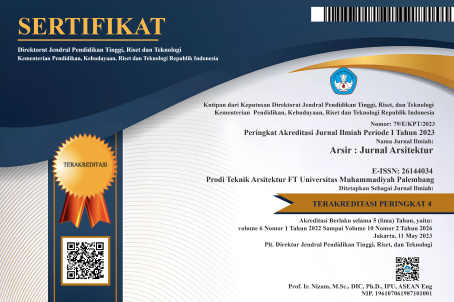Correspondence Analysis in the Study of Adaptive Transformation of Riverbank Settlement Architecture
DOI:
https://doi.org/10.32502/arsir.v9i1.360Keywords:
adaptive transformation, correspondence analysis, pontianak, riverside settlement, settlement cultureAbstract
This study examines adaptive transformation in riverbank settlements along the Kapuas River in Pontianak, focusing on socioeconomic factors that influence community adaptation in Kampung Kamboja, Kampung Tambelan, and Kampung Beting. Using a quantitative explanatory approach, this study applies Correspondence Analysis to analyze the relationship between location and settlement adaptation characteristics. The findings show that dominant factors driving physical changes in housing include family expansion, the orientation of walkways (gertak), and building damage. Economic limitations and strong social bonds also play significant roles, alongside government policy support in riverbank areas aimed at promoting a tourist village program. The Correspondence Analysis method helps identify the most influential factors in a measurable and specific way, enhancing insights into varied adaptation patterns. This study contributes to the development of quantitative methods for understanding settlement adaptation dynamics while providing a foundation for sustainable riverbank area preservation and development planning
Downloads
Published
How to Cite
Issue
Section
License
Copyright (c) 2025 Hamdil Khaliesh, Zairin Zain

This work is licensed under a Creative Commons Attribution-ShareAlike 4.0 International License.
Arsir: Jurnal Arsitektur (AJA) have CC-BY-SA or an equivalent license as the optimal license for the publication, distribution, use, and reuse of scholarly work.
Authors who publish Arsir: Jurnal Arsitektur (AJA) agree to the following terms: Authors retain copyright and grant the Arsir: Jurnal Arsitektur (AJA) right of first publication with the work simultaneously licensed under a Creative Commons Attribution License (CC BY-SA 4.0) that allows others to share (copy and redistribute the material in any medium or format) and adapt (remix, transform, and build upon the material) the work for any purpose, even commercially, with an acknowledgement of the work's authorship and initial publication in Arsir: Jurnal Arsitektur (AJA). Authors are able to enter into separate, additional contractual arrangements for the non-exclusive distribution of the journal's published version of the work (e.g., post it to an institutional repository or publish it in a book), with an acknowledgement of its initial publication in Arsir: Jurnal Arsitektur (AJA). Authors are permitted and encouraged to post their work online (e.g., in institutional repositories or on their website) prior to and during the submission process, as it can lead to productive exchanges as well as earlier and greater citation of published work (see The Effect of Open Access).
![]()
Work is distributed below This work is licensed under a Creative Commons Attribution-ShareAlike 4.0 International License.










